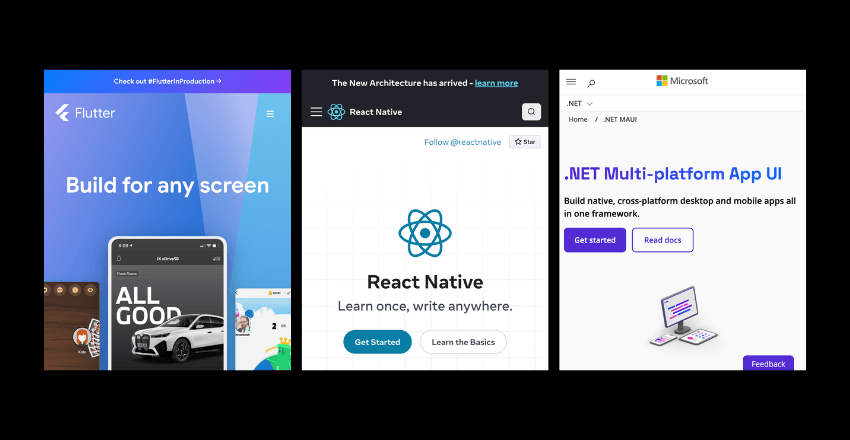
Cross-platform development solutions for launching enterprise mobile apps across iOS and Android
At the heart of many enterprise digital strategies lies a critical challenge: the need to deliver high-quality mobile applications that run seamlessly on both iOS and Android. This is essential for companies aiming to engage customers and employees, improve productivity, and drive innovation.
Thank you for reading this post, don't forget to subscribe!Yet, developing native applications for both platforms has traditionally been expensive, slow, and complex. For enterprises managing large-scale digital operations, this challenge often translates into high development costs, fragmented development efforts, and maintenance overhead.
Cross-platform development solutions are reshaping how enterprises approach mobile app launches by offering a unified development experience that reduces costs, accelerates timelines, and improves overall code maintainability. In fact, some leading companies have reported up to 50 percent savings on development time and costs by adopting modern cross-platform frameworks.
Overcoming Traditional Development Challenges
The Two Conventional Options: Native vs. Hybrid
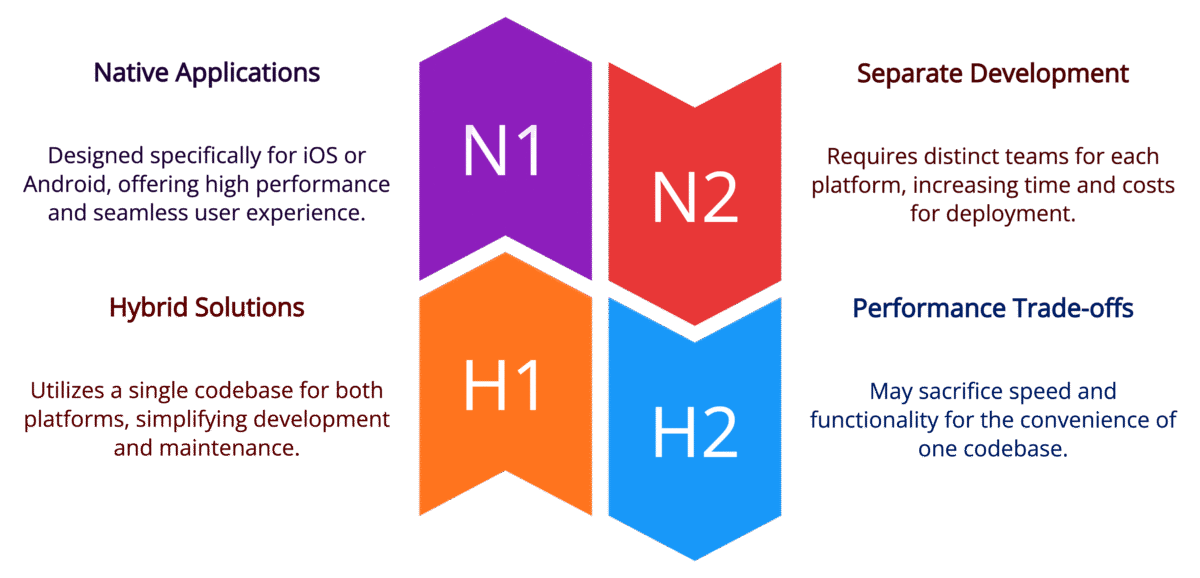
When enterprises set out to launch mobile applications, they traditionally faced two paths:
- Develop native applications for both iOS and Android platforms.
- Use hybrid solutions that offered a single codebase but came with performance trade-offs.
Both options presented significant challenges, especially for large enterprises managing complex digital ecosystems.
Native Development required separate development efforts for each platform, resulting in two distinct codebases. Each platform had unique programming languages (Swift/Objective-C for iOS and Java/Kotlin for Android), frameworks, and design guidelines. This meant enterprises needed to maintain separate development teams and skillsets. Bugs, feature updates, and optimizations had to be addressed independently for each platform, creating duplicate work and slowing down time-to-market.
On the other hand, hybrid solutions like Apache Cordova or early versions of Xamarin (no longer supported) aimed to offer a unified development experience by using web technologies like HTML, CSS, and JavaScript. However, these approaches were plagued by performance issues, poor user experience, and limited access to native device capabilities. This often led to apps that felt sluggish and failed to meet user expectations.
The Cost of Operational Inefficiency and Technical Debt
Enterprises that adopted the native development approach often encountered severe operational inefficiencies. Managing two codebases doubled the effort required to implement new features, troubleshoot bugs, and roll out updates. This created ongoing challenges, including:
- Delayed product releases due to duplicate development cycles.
- Higher costs from employing two specialized teams of developers.
- Technical debt accumulation as both codebases diverged over time, making it difficult to maintain feature parity.
Many businesses found themselves stuck in a reactive mode, constantly playing catch-up with updates, security patches, and platform changes. This was unsustainable in a fast-paced digital landscape where rapid innovation and seamless user experiences are essential for competitiveness.
Modern Cross-platform Frameworks
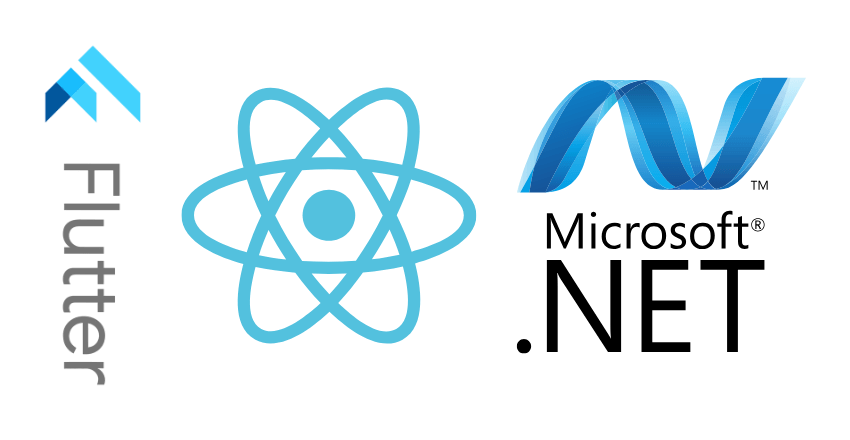
Recent advancements in cross-platform frameworks have redefined how enterprises approach mobile app development. Frameworks like Flutter (by Google), React Native (by Meta), and .NET MAUI (Multi-platform App UI) enable developers to write code once and deploy it across both iOS and Android, significantly reducing operational complexities.
Note: Microsoft officially ended support for Xamarin on May 1, 2024. It has since been succeeded by .NET MAUI, which builds on Xamarin.Forms to offer a more scalable and robust cross-platform solution for mobile and desktop apps. Enterprises migrating from Xamarin are advised to adopt .NET MAUI for modern cross-platform development needs.
These modern frameworks provide several key advantages:
1. Single Codebase for Both Platforms
Developers can write application logic in a unified codebase, which eliminates the need for separate development efforts. This reduces duplicate work, accelerates feature development, and simplifies maintenance. Frameworks like Flutter and React Native offer near-native performance by using advanced rendering engines and native modules to interact with device hardware. .NET MAUI further enhances productivity by allowing developers to build mobile and desktop apps from a single project structure.
2. Consistent User Experience
Unlike early hybrid approaches, modern cross-platform frameworks prioritize user experience. Flutter, for example, uses a highly performant rendering engine that replicates native UI components across platforms. React Native leverages native components directly, ensuring that apps feel responsive and maintain the design consistency expected by users of each platform. .NET MAUI similarly provides platform-specific UI rendering to ensure a seamless experience for both mobile and desktop users.
3. Accelerated Development and Testing
With a single codebase, developers can implement new features and bug fixes once and deploy them across both platforms simultaneously. This speeds up development cycles and reduces the testing burden. Additionally, features like hot reload (offered by both Flutter and React Native) allow developers to instantly see changes in the app without recompiling, further boosting productivity. .NET MAUI integrates similar tools to streamline the development and debugging process.
4. Improved Collaboration Across Teams
Cross-platform solutions enable tighter collaboration between teams. Business stakeholders, designers, and engineers can work with a unified development pipeline, improving communication and reducing the risk of feature misalignment. Teams can also leverage shared libraries, components, and APIs, further streamlining development efforts.
Enterprise Cross-platform Adoption
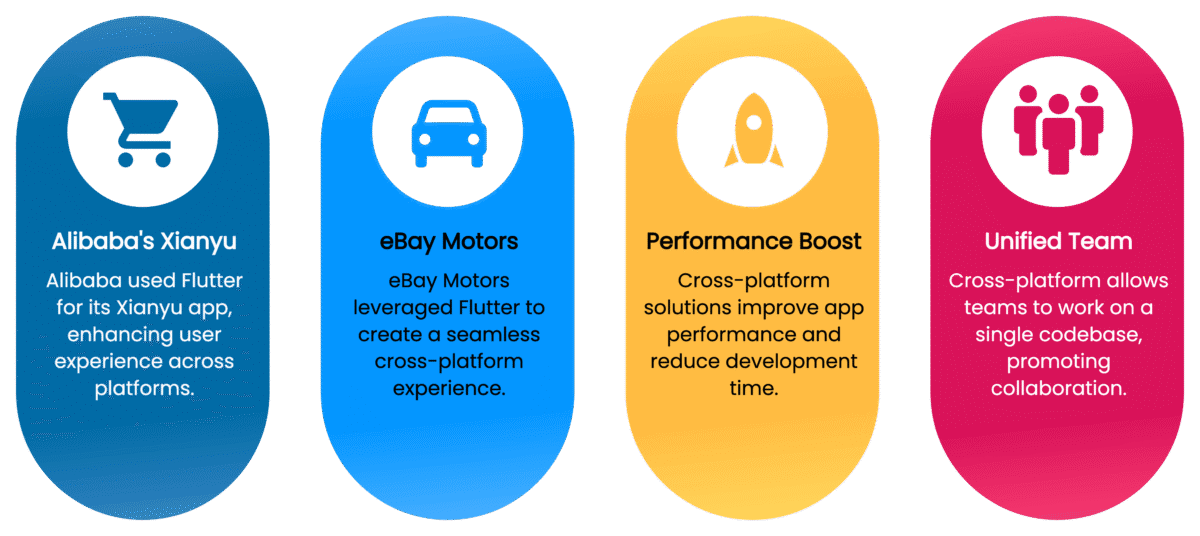
Many enterprises have successfully modernized their mobile app strategies by adopting cross-platform solutions. Consider the following examples:
- Alibaba: The Chinese e-commerce giant utilized Flutter to develop its Xianyu (also known as Idle Fish) app, a marketplace for second-hand goods. By adopting Flutter, Alibaba was able to maintain a single codebase, which streamlined development and ensured a smooth user experience across platforms.
- eBay Motors: eBay employed Flutter to create a dedicated app for its automobile segment. The development team appreciated Flutter’s fast development cycle, native tools, and the ability to share approximately 98.3% of the code between iOS and Android platforms. This approach enabled them to release the beta version of the app within three months.
Despite their benefits, cross-platform frameworks are not a one-size-fits-all solution. Some highly complex applications, particularly those requiring extensive integration with platform-specific features like augmented reality (AR) or advanced security modules, may still require native development for certain components. However, modern frameworks have made significant strides in supporting a wide range of native features, often through plugin ecosystems and custom native modules.
Enterprises should carefully assess their business needs, technical requirements, and long-term scalability goals when selecting a development approach. In many cases, hybrid solutions are no longer necessary as modern cross-platform frameworks provide both performance and flexibility without sacrificing user experience.
Leveraging Cross-platform Development for Business Outcomes
Cross-platform frameworks today provide more than just cost efficiency. They enable companies to deliver high-performance, feature-rich mobile experiences without compromising user satisfaction. However, simply converting native code to a cross-platform solution is not enough. Enterprises must prioritize improving business processes and outcomes through strategic use of these tools.
One of the key advantages of modern cross-platform solutions is the ability to maintain a single source of truth for application logic, which reduces the risk of feature drift across platforms. For example, an enterprise fintech app built using Flutter can ensure that critical business processes—such as payment processing and transaction tracking—behave consistently across devices, thereby improving user trust and engagement.
Moreover, these frameworks support rapid prototyping and iterative development. Engineers can collaborate more closely with business stakeholders to experiment with new features, gather feedback quickly, and deploy updates faster than would be feasible with separate native development teams.
Autonomous Development Agents
The next frontier in cross-platform development is the use of AI-driven agents to streamline workflows and improve productivity. Generative AI tools can assist developers by automating repetitive tasks, such as code generation, UI design, and testing. In this context, AI agents act as co-developers, accelerating the development lifecycle while ensuring code quality and security.
For instance, an enterprise healthcare app development team might deploy a set of generative AI agents to handle data mapping, compliance checks, and security testing. These agents can autonomously perform data analysis, generate technical documentation, and identify potential vulnerabilities, allowing human developers to focus on strategic features and innovation.
As companies scale their AI-driven development efforts, the coordination of multiple AI agents will become crucial. Sophisticated orchestration platforms can manage these agents, ensuring they collaborate effectively on complex tasks such as API integrations and cross-platform optimizations.
Scaling Cross-platform Development Capabilities
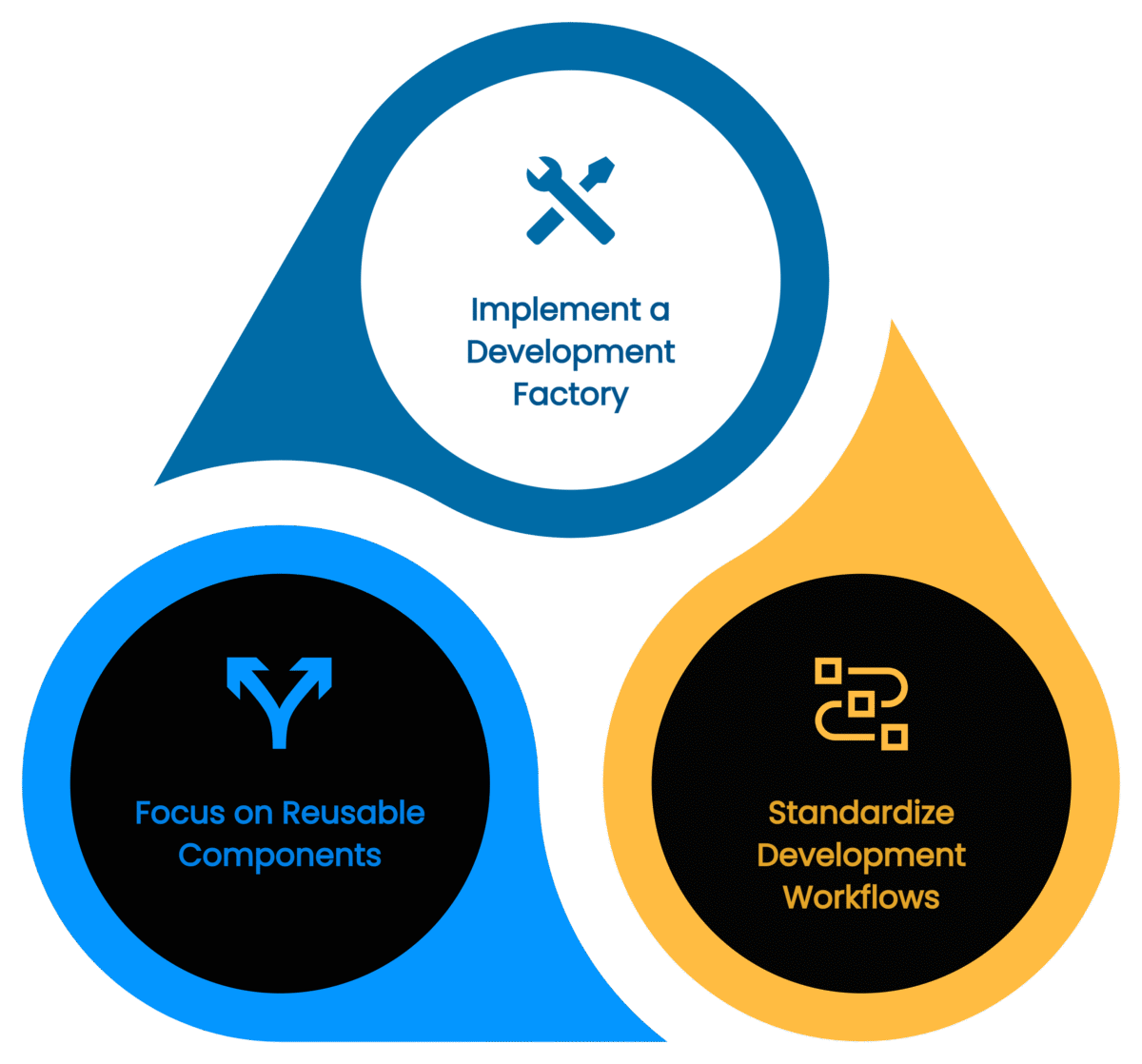
The true value of cross-platform development lies in its ability to scale across multiple business units and applications. Enterprises should focus on building a scalable development ecosystem that includes reusable components, standardized workflows, and centralized platforms for version control, testing, and deployment.
To achieve this, technology leaders should consider implementing two key components:
- Development Factory: A cross-platform development factory consists of multidisciplinary teams focused on building and maintaining reusable libraries, design systems, and development tools. By centralizing these resources, enterprises can accelerate development cycles and ensure consistency across apps.
- Development Platform: A standardized platform provides enterprise-wide services such as CI/CD pipelines, cloud integration, and monitoring. This platform should be designed to support multiple cross-platform frameworks and technologies, enabling teams to choose the best solution for each use case while maintaining overall alignment with enterprise goals.
Next Steps for Enterprise Success
Enterprises looking to enhance their cross-platform development strategies should consider the following actions:
- Evaluate Framework Suitability: Assess the strengths and limitations of frameworks such as Flutter, React Native, and .NET MAUI in the context of your business needs. Focus on how these solutions can help reduce time-to-market and enhance user experience.
- Prioritize Business Objectives: Avoid the temptation to migrate applications solely for technical reasons. Instead, align development efforts with strategic business goals, such as improving customer engagement or streamlining employee workflows.
- Integrate Generative AI Tools: Explore opportunities to incorporate AI-driven development agents into your workflows. These agents can help automate routine tasks, accelerate testing, and enhance code quality.
- Develop a Scalable Ecosystem: Invest in building a scalable development ecosystem that supports cross-platform innovation at scale. This includes creating reusable libraries, optimizing infrastructure, and fostering collaboration across development teams.
Adopting modern cross-platform solutions and integrating AI-driven development agents, enterprises can overcome the traditional challenges of mobile app development. This approach not only reduces technical debt but also empowers companies to deliver innovative, high-quality applications faster and at a lower cost. As digital transformation continues to reshape industries, enterprises that master cross-platform development will be well-positioned to drive growth and create lasting value.


